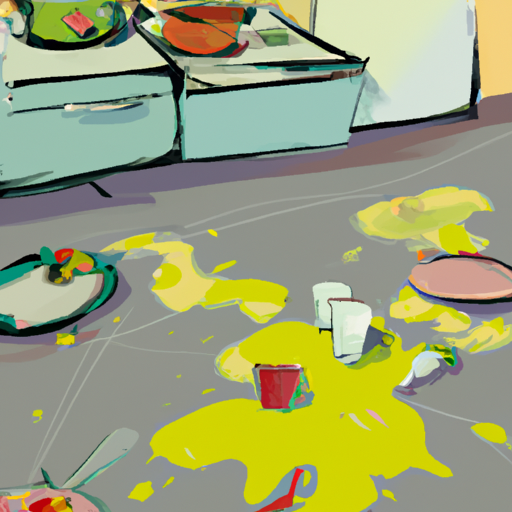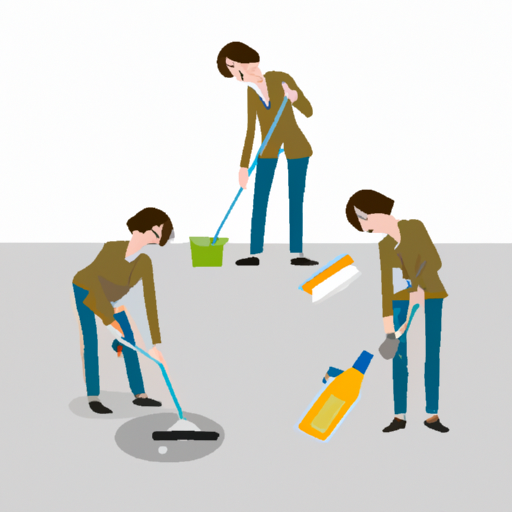Tired of mopping yet ending up with a greasy, sticky kitchen floor? Introducing 'The Ultimate Guide to Cleaning Kitchen Floors'! This guide is your one-stop solution to a spotless, sparkling kitchen floor. It offers comprehensive, step-by-step instructions on selecting the best cleaning products, using the correct cleaning techniques, and maintaining the cleanliness of your kitchen floor over time.
Why is cleaning your kitchen floor regularly important?
Cleaning your kitchen floor regularly is crucial for several reasons. Firstly, a clean kitchen floor helps maintain a hygienic environment. With the constant traffic of food preparation, spills, and foot traffic, bacteria and germs can easily accumulate on the floor surface. Regular cleaning helps eliminate these harmful microorganisms, reducing the risk of contamination and foodborne illnesses.
Secondly, a clean kitchen floor enhances the overall appearance of your kitchen. A dirty floor can make even the cleanest countertops and appliances look unkempt. Regular cleaning ensures that your kitchen floor remains sparkling clean, creating a visually appealing and inviting space for cooking and entertaining.
Moreover, cleaning your kitchen floor regularly helps prolong its lifespan. Over time, dirt, debris, and food particles can scratch and damage the floor surface, especially if left unattended. By regularly sweeping, mopping, and caring for your kitchen floor, you can prevent these damages, saving you the cost and hassle of repairs or replacements in the future.
Finally, a clean kitchen floor promotes safety. Spills and wet surfaces can create slippery conditions, increasing the risk of accidents and injuries. By promptly cleaning up spills and regularly maintaining your kitchen floor, you can ensure a safe environment for yourself and your family members.
An image showing a dirty kitchen floor with food spills and stains
What's the best cleaning product for your kitchen floor?
When it comes to choosing the best cleaning product for your kitchen floor, there are several options to consider. One popular choice is a pH-neutral floor cleaner. pH-neutral cleaners are gentle yet effective in removing dirt, grease, and grime from various floor surfaces without causing any damage or discoloration. They are suitable for a wide range of flooring materials, including tile, vinyl, laminate, and hardwood.
Another great option is a steam mop. Steam mops use the power of steam to deep clean and sanitize your kitchen floor. They are particularly beneficial for tile and grouted floors, as the steam helps to loosen and remove stubborn stains and dirt. Additionally, steam mops are environmentally friendly, as they do not require the use of harsh chemicals.
For those with hardwood floors, it is important to choose a cleaning product specifically formulated for this type of flooring. Hardwood floor cleaners are designed to gently remove dirt and grime without damaging the wood or leaving behind any residue. These cleaners typically come in spray or liquid form and can be applied with a mop or microfiber cloth.
In addition to these options, it's always a good idea to check the manufacturer's recommendations for cleaning products for your specific type of flooring. They may have specific guidelines or products that are recommended to ensure the longevity and beauty of your kitchen floor.
"The art of cleaning: Techniques to achieve a squeaky-clean floor"
Cleaning your kitchen floor is not just about removing visible dirt and stains; it's about achieving a squeaky-clean surface that looks and feels fresh. To master the art of cleaning your kitchen floor, there are a few techniques you can employ.
First, start by sweeping or vacuuming the floor to remove loose dirt and debris. This step is essential to prevent scratching the surface during the cleaning process. Use a broom or vacuum with a soft brush attachment to ensure gentle yet effective cleaning.
Next, consider spot-cleaning any stubborn stains or spills. For this, you can use a mild detergent or a mixture of warm water and vinegar. Apply the solution to the affected area and gently scrub with a soft brush or sponge. Rinse thoroughly and dry the area to prevent any residue.
When it comes to mopping, choose a microfiber mop or a mop with soft, absorbent pads. Microfiber is excellent for trapping dirt and grime, providing a thorough clean. Avoid using excessive water, as it can seep into cracks and cause damage. Instead, dampen the mop with a suitable floor cleaner and wring out any excess moisture before mopping.
Pay attention to the direction you mop in. It is recommended to mop in a figure-eight or S-shaped pattern to ensure complete coverage and prevent streaks. Be sure to change the mop pad or rinse it frequently to avoid spreading dirt around.
Finally, allow the floor to air dry or use a clean, dry mop or towel to speed up the drying process. This will prevent any water spots or streaks from forming on the surface.
An illustration of a person using different cleaning techniques on a kitchen floor
"Maintenance is key: How to preserve your kitchen floor's cleanliness over time?"
When it comes to maintaining the cleanliness of your kitchen floor over time, there are a few key practices you can adopt. By following these steps, you can extend the lifespan of your floor and keep it looking pristine.
- 1. Regular Sweeping and Vacuuming:
One of the simplest yet most effective ways to preserve the cleanliness of your kitchen floor is through regular sweeping and vacuuming. Make it a habit to remove loose dirt, crumbs, and debris on a daily basis. This will prevent them from getting ground into the floor and causing scratches or stains. - 2. Promptly Clean Spills and Stains:
Accidents happen in the kitchen, and spills are inevitable. However, it's crucial to clean up spills and stains as soon as they occur to prevent them from setting in and becoming harder to remove. Use a mild cleaner or a mixture of warm water and vinegar to tackle any spills promptly. Avoid using harsh chemicals that could damage the floor's surface. - 3. Use Protective Mats and Rugs:
Prevention is key when it comes to maintaining a clean kitchen floor. Placing mats or rugs in high-traffic areas, such as near the sink or stove, can help protect the floor from spills, scratches, and wear and tear. These mats can be easily cleaned or replaced, saving your floor from unnecessary damage. - 4. Regular Deep Cleaning:
In addition to daily maintenance, periodic deep cleaning is essential to keep your kitchen floor in top shape. Depending on the type of flooring you have, consult the manufacturer's instructions for recommended cleaning methods. This may involve using specialized floor cleaners or hiring professional services for a thorough clean.
Cleaning Kitchen Floors Guide:
| Step | Product | Instructions | Time |
|---|---|---|---|
| Select Appropriate Cleaning Product | Dish Soap, Vinegar, Baking Soda | Choose a product that is appropriate for your type of flooring. | 5 minutes |
| Mix Cleaning Solution | Dish Soap, Vinegar, Baking Soda, Hot Water | Mix the appropriate cleaning product with hot water to create a cleaning solution. | 5 minutes |
| Mop the Floor | Mop, Cleaning Solution | Mop the floor with the cleaning solution and a clean mop. | 15 minutes |
| Rinse Floor | Mop, Clean Water | Rinse the floor with clean water and a clean mop to remove any remaining cleaning solution. | 10 minutes |
Whether it's a stubborn stain or a quick spill, a flawless kitchen floor is within your reach. With the right tools, cleaning products, and a little bit of elbow grease, your kitchen floor can shine like new. Remember, cleanliness is next to godliness. So, start cleaning and take a step towards a healthier, happier kitchen!



